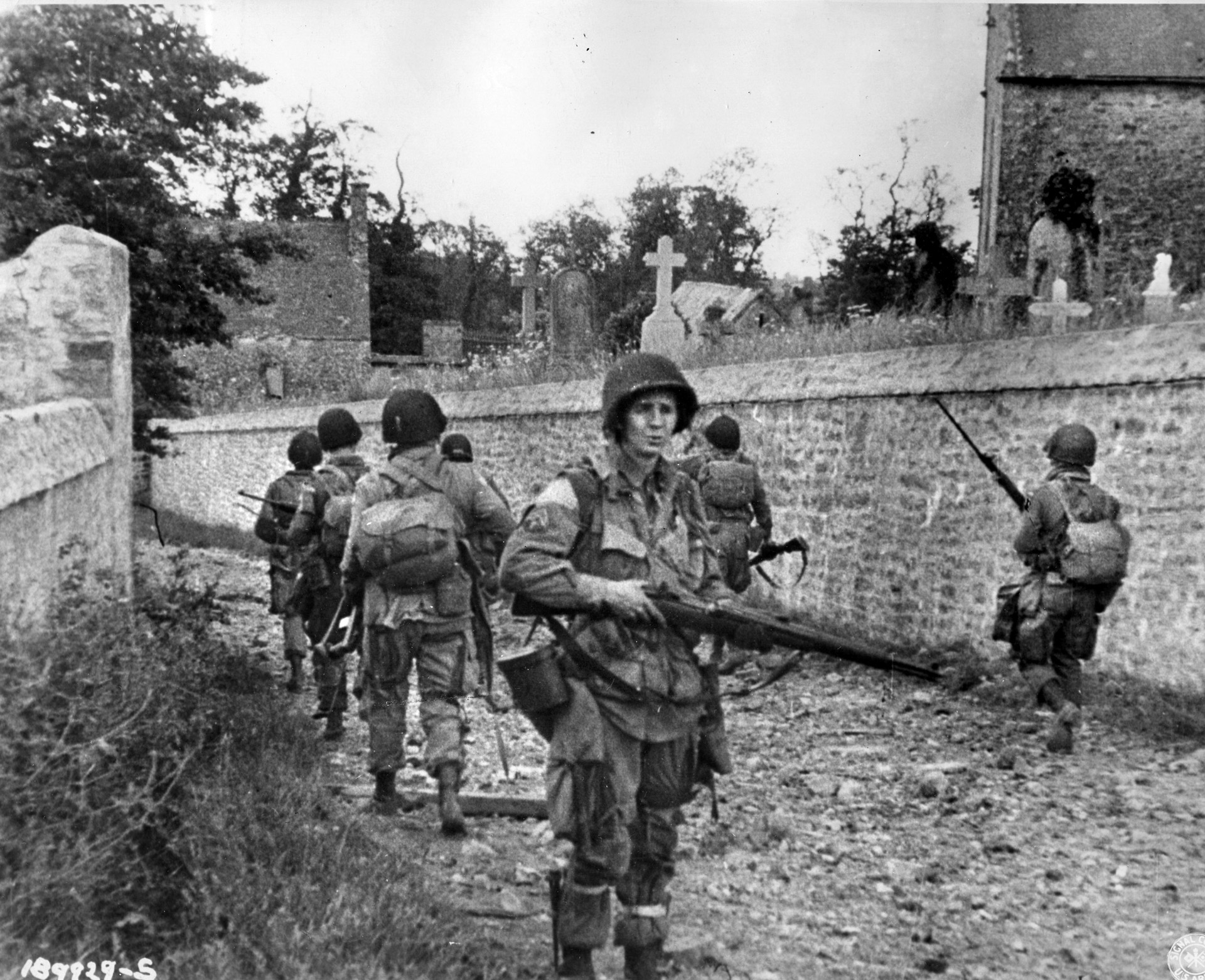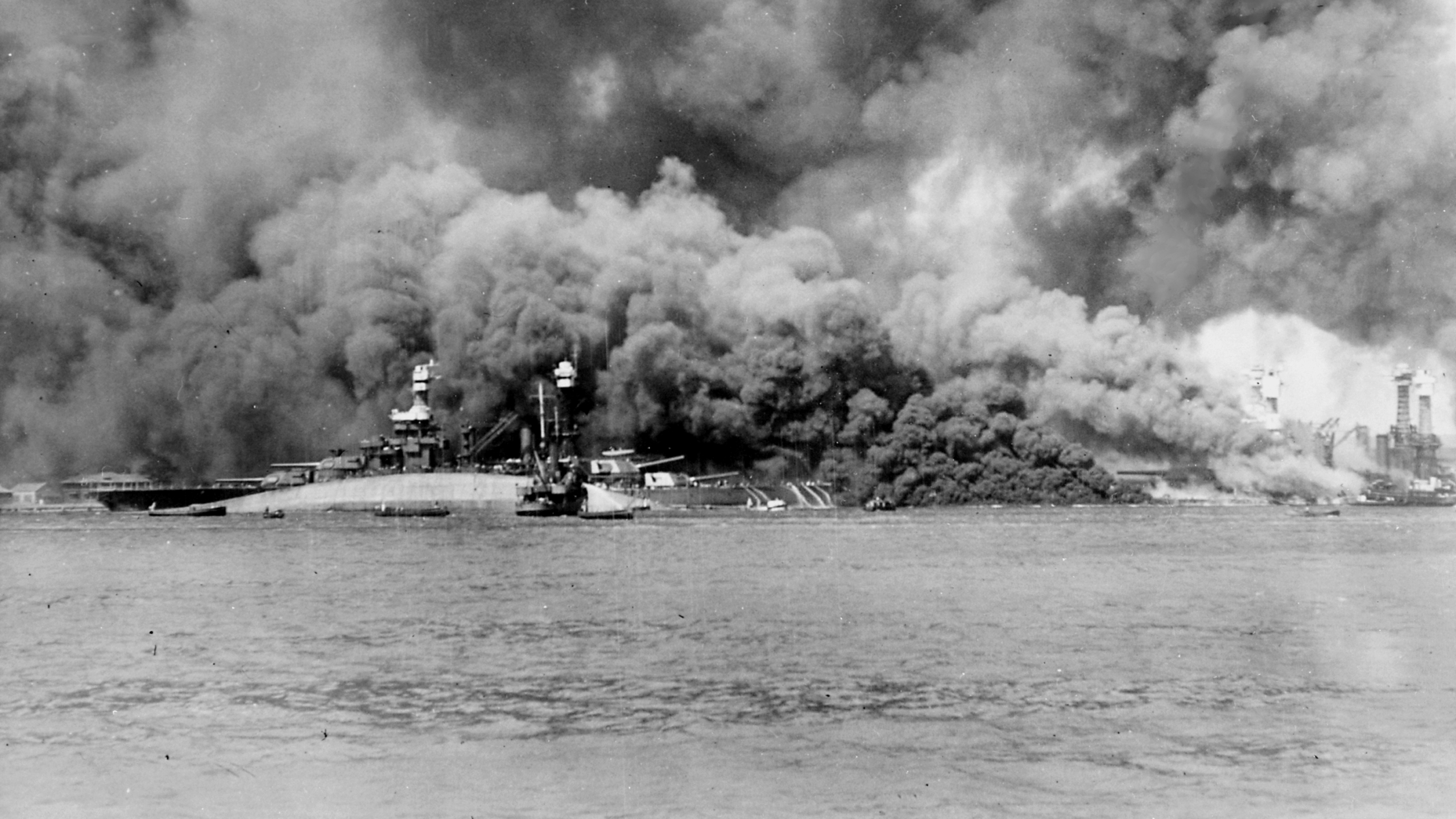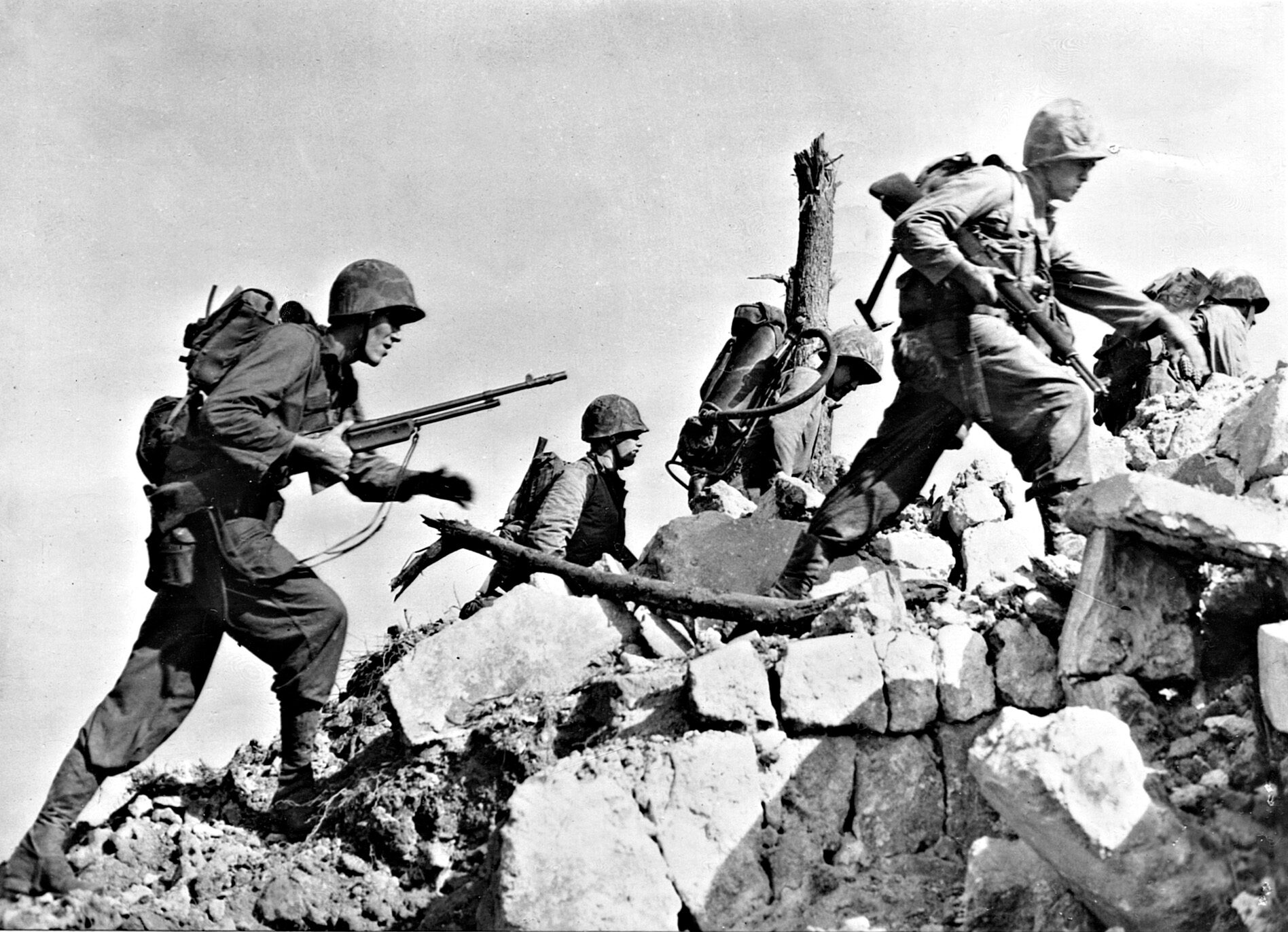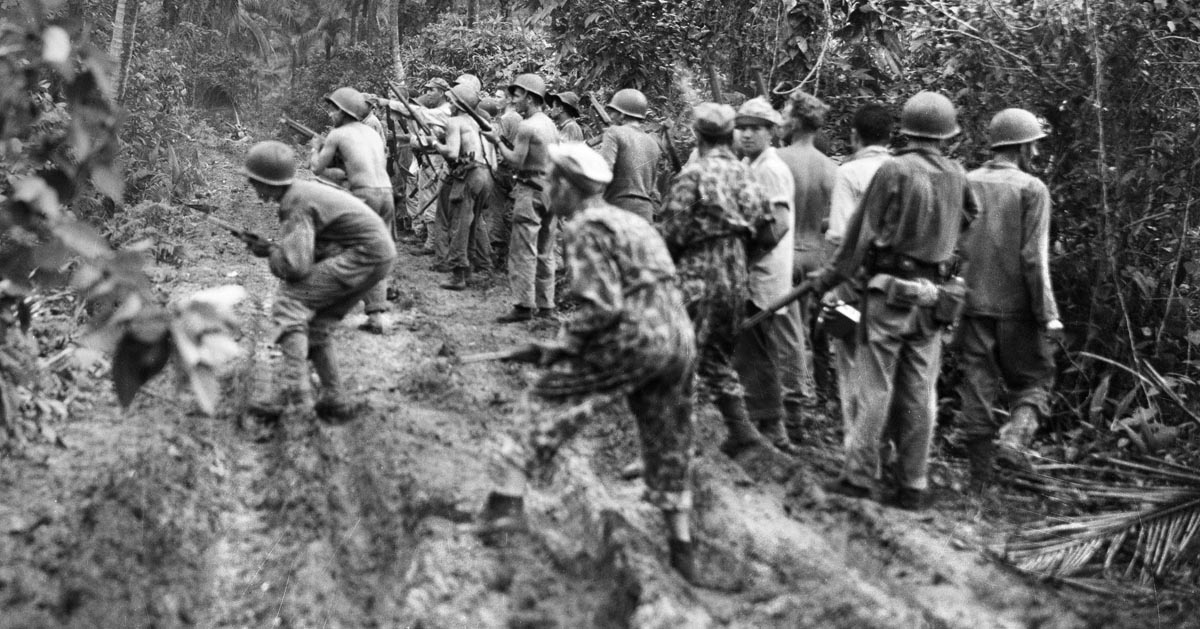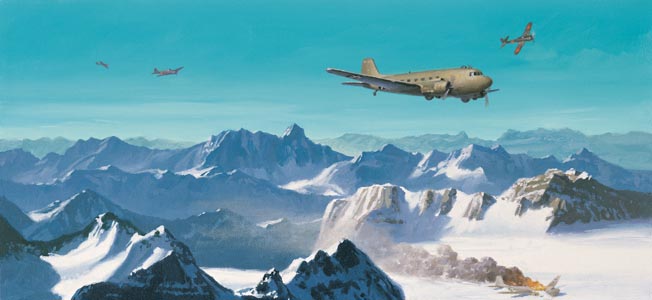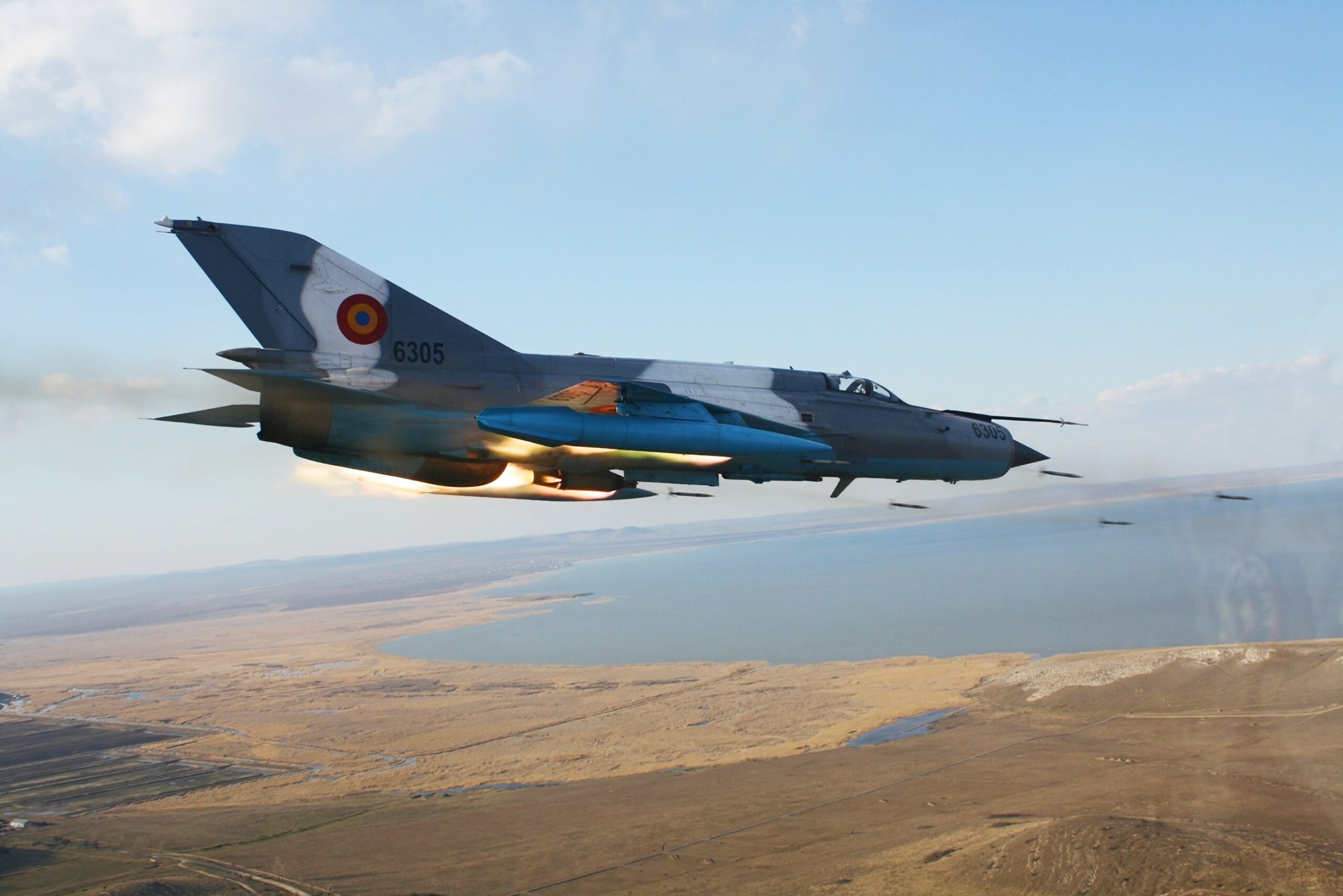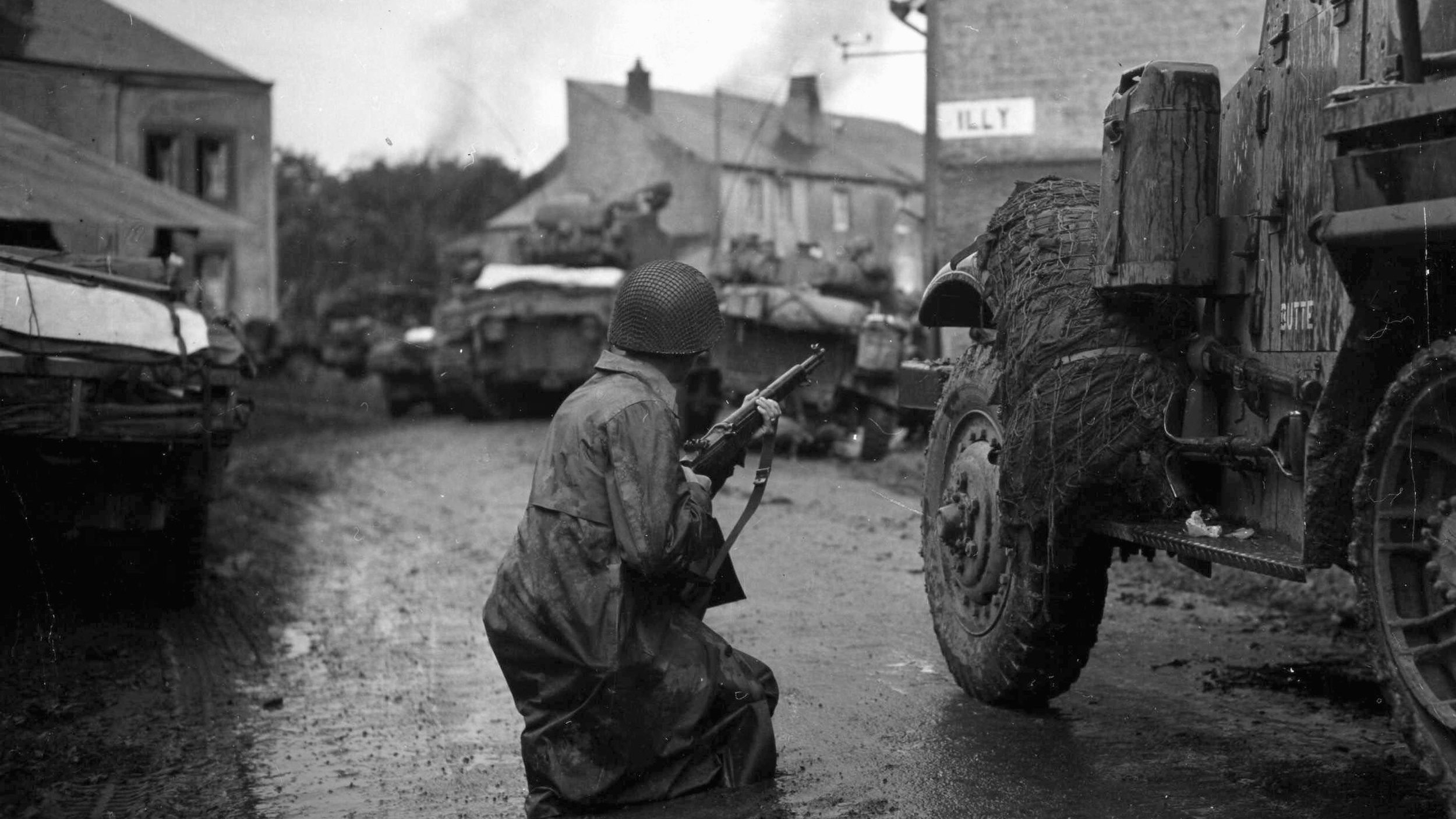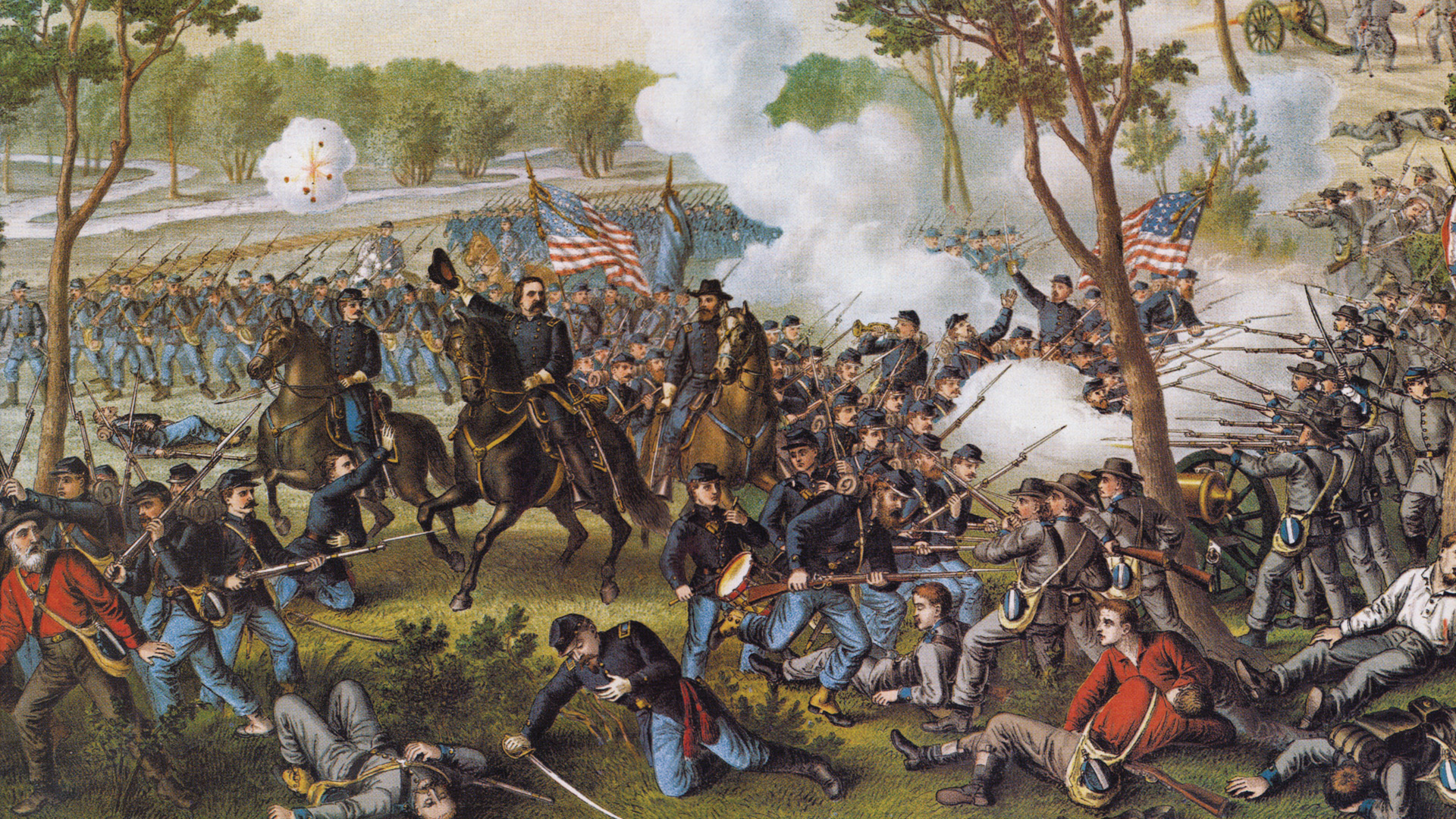By Christopher Miskimon
Unlike many of the paratroopers in the U.S. 82nd Airborne Division, 1st Lieutenant John J. Dolan knew exactly where he was when he landed on June 6, 1944.
In the early hours of D-Day, many of the planes dropping the division over the Normandy countryside veered off course or got scattered by enemy antiaircraft fire. As a result, some units landed miles from their assigned objectives. After practicing and memorizing their missions before the actual drops, these men had to improvise, either searching out their targets in the dark or simply starting their part of the war from where they were and worrying about finding their units later.
Lieutenant Dolan and his men, A Company, 505th Parachute Infantry Regiment, were fortunate in their landing location that night. The C-47 transport planes carrying them into battle arrived over the drop zone perfectly, their pilots flying straight and true. The paratroopers in each aircraft stood in a line, waiting for the signal to jump. They hooked the lines from their parachutes to the static line in the fuselage. After that, equipment checks for any last-minute problems. While they did all this, tracers from German guns flashed past their planes. Some of the men could hear rounds hitting the wings.
A fire in the village of Ste.-Mère-Église, a town near the drop zone, had French civilians out passing buckets in a line across from the church in the town square. As they worked, the C-47s appeared overhead, wings so close they almost touched. Inside the planes the signal to go, a green light, finally lit the compartment. The lead soldier jumped out the door, and the rest followed him into the night sky. One 505th paratrooper, Private Arthur DeFilippo, watched the tracers coming at him and recalled, “All I did was pray to God that He would get me down safely and then I would take care of myself.” It was about 1:30 am.
Dolan landed without a problem and immediately began figuring out exactly where he was. It took no more than half an hour before he found a “T” intersection of two dirt roads. Each was about eight or 10 feet wide, with the horizontal arm of the T running east-west and the vertical arm going north-south. He now knew his unit landed in its assigned drop zone, exactly on target. The north-south dirt road led south to another road, which ran between Ste.-Mère-Église and a bridge over the Merderet River at La Fière. This bridge was Dolan’s assignment; his company had to take that bridge and hold it until relieved.
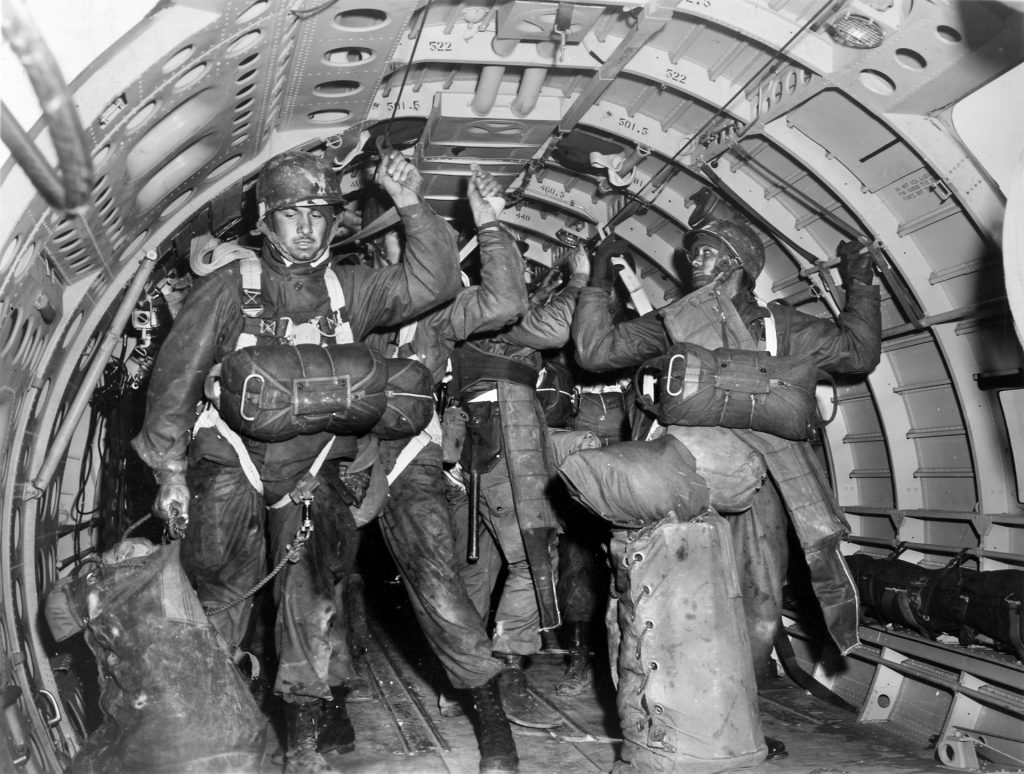
A Company had the usual problems assembling after a night jump. The darkness made it difficult to gather the men into their assigned squads and platoons. About an hour before dawn, they were finally ready, with 90 percent of the company accounted for. Dolan later credited this to the extensive night training the unit had done before the invasion and the actions of the officers and NCOs. With A Company assembled and ready, Dolan led them toward the bridge.
The airborne drops formed a vital part of the Normandy invasion of June 6, 1944. Through both design and circumstance, the paratroopers of the three Allied airborne divisions fulfilled multiple goals. They seized crucial crossroads and communications routes, preventing German reinforcements from getting to the beaches and holding them until Allied troops could advance from those beachheads and link up with them. Even when drops were inaccurate due to the chaos of combat, those paratroopers who were scattered across the countryside would band together into small groups and either try to get to their assigned targets or do what damage they could where they were. This further stressed the German defenders, who had to discern which attacks posed the greatest threat as their strength was diluted reacting to myriad small assaults.
For the 82nd Airborne Division, nicknamed the “All Americans,” their portion of the Allied drops was codenamed Boston. Lieutenant Colonel William Elkman’s 505th Parachute Infantry Regiment (PIR) was one of the division’s two assigned parachute regiments and had served in Sicily and Italy before transferring to England for the invasion of Western Europe. The other regiment, the 504th, had also served in Italy but arrived in England after taking heavy casualties and could not be brought up to strength in time to take part in the D-Day operation. Instead, two other PIRs, the 507th and 508th, were attached to the division for the operation. Many of the 505th’s soldiers were replacements for men lost in the Mediterranean, but they were well-trained and motivated. Only volunteers could serve in airborne units.
The plan for the 505th on D-Day centered around the French crossroads town of Ste.-Mère-Église. The regiment contained three battalions. The First Battalion (1/505) under Major Frederick Kellam was tasked to seize and hold two bridges over the Merderet River, at La Fière and Chef-du-Pont. Lt. Col. Ben Vandervoort’s 2/505 would occupy the ground north of the town to block the road to Cherbourg. The 3/505’s (Lt. Col. Edward Krause) assignment was to take Ste.-Mère-Église itself. The town sat on the N13 Road and was located west of Utah Beach. German counterattacks against either Utah or Omaha beaches would need this road for ease of movement.
The bridge at La Fière lay a few miles west of Ste.-Mère-Église. This small bridge, sometimes referred to as a causeway, connected the road on each side of the narrow Merderet; the road was elevated due to frequent flooding during the rainy season. In June, the Merderet should have been narrow and shallow, but the locks at Carentan had been opened, flooding much of the terrain. The ground around the bridge was either marsh or sodden farm fields. A small manor house sat just south of the bridge, and the hamlet of Cauquigny was just over half a mile west of the bridge along the road. La Fière itself was little more than a small collection of buildings a few hundred yards northwest of the bridge.
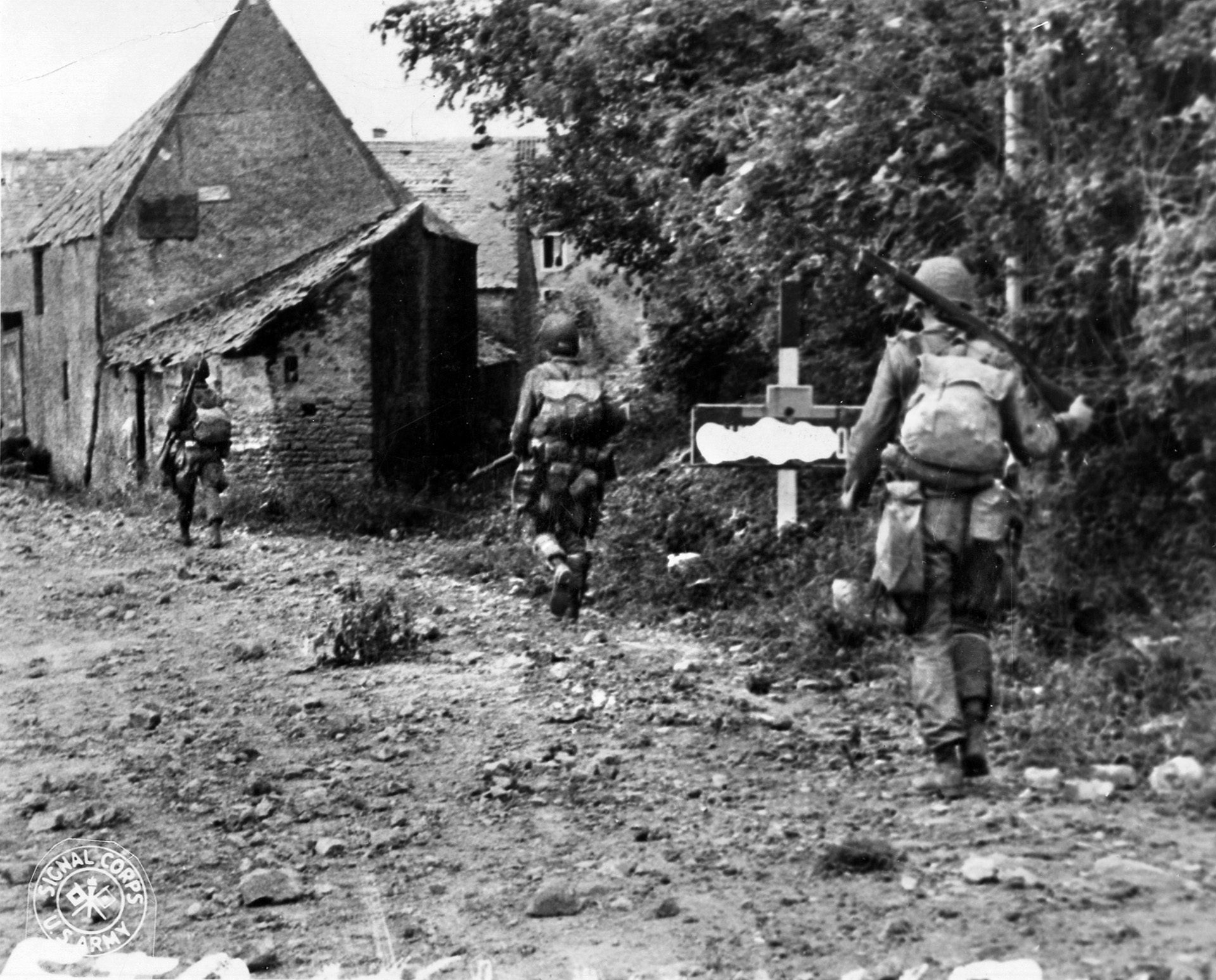
Several German units populated the area as part of the defense plan. The commander of the overall German defense, Field Marshal Erwin Rommel, wanted to place his reserve panzer divisions near the likely landing beaches so they could quickly respond, but instead the tanks were kept well back from the coast, making them unavailable in the first crucial hours. Further, they could not be moved without Hitler’s personal authorization. Rommel had to make do with less-powerful infantry formations supported by whatever small armored and artillery units he could obtain. The local command in the area of the airborne landings was the LXXXIV Korps.
The Wehrmacht units that took part in the fighting for La Fière mainly fell under the 91st Airlanding Division (91. Luftlande-Division), headquartered about nine miles due west of Ste.-Mère-Église. Like other units stationed in the countryside behind the possible Allied landing beaches, the 91st’s role was to quickly respond to whatever area came under attack, whether by beach assault or airborne intrusion. It was a new unit, having only been raised at the beginning of 1944. The main strength of the division consisted of two grenadier regiments, numbered 1057 and 1058. Each regiment had three battalions, supported by an infantry cannon company and an anti-tank company. The division also had a fusilier battalion with three independent companies: one antitank, one antiaircraft, and one of bicycle troops. Other division troops included an engineer battalion and an artillery regiment with 24 105mm mountain howitzers and 12 88mm Pak 43 antitank guns.
The 91st’s regiments were based west and northwest of Ste.-Mère-Église and received equipment based on their intended role in air-landing operations, roughly similar to the glider regiments in American airborne divisions. For example, the mountain howitzers were lightweight models more easily transported by airlanding troops. Unfortunately, they fired a different sized ammunition than the standard German 105mm weapon, and the 91st only had a single basic load of ammunition on hand. The division was also understrength, only partially trained, and had few transport vehicles, a common problem for German units in Normandy.
The German command appreciated these difficulties and attached two additional units to the 91st. One was Parachute Regiment 6, a German airborne unit positioned south of Ste.-Mère-Église and near Carentan. It arrived in the area at the end of May. The other was Panzer Replacement and Training Battalion 100, whose main role was preparing new tank crews for combat. The unit used old French tanks captured in 1940, organized into two companies with a total of about 25 Renault R 35s and Hotchkiss H 39s. A single Panzer Mark III comprised the battalion’s entire German tank inventory.
These combined units were expected to react quickly to Allied attacks, using the very road networks the American paratroopers would interdict on the night of June 6. The 82nd Airborne began landing around 1:00 am on D-Day. Word got to the German 84th Korps just 11 minutes later. The initial reports caused some confusion, not unusual for the opening moments of an enemy attack. One thing the Germans knew from experience was to react quickly with local counterattacks to keep the enemy paratroopers from organizing and forming a coherent defense.
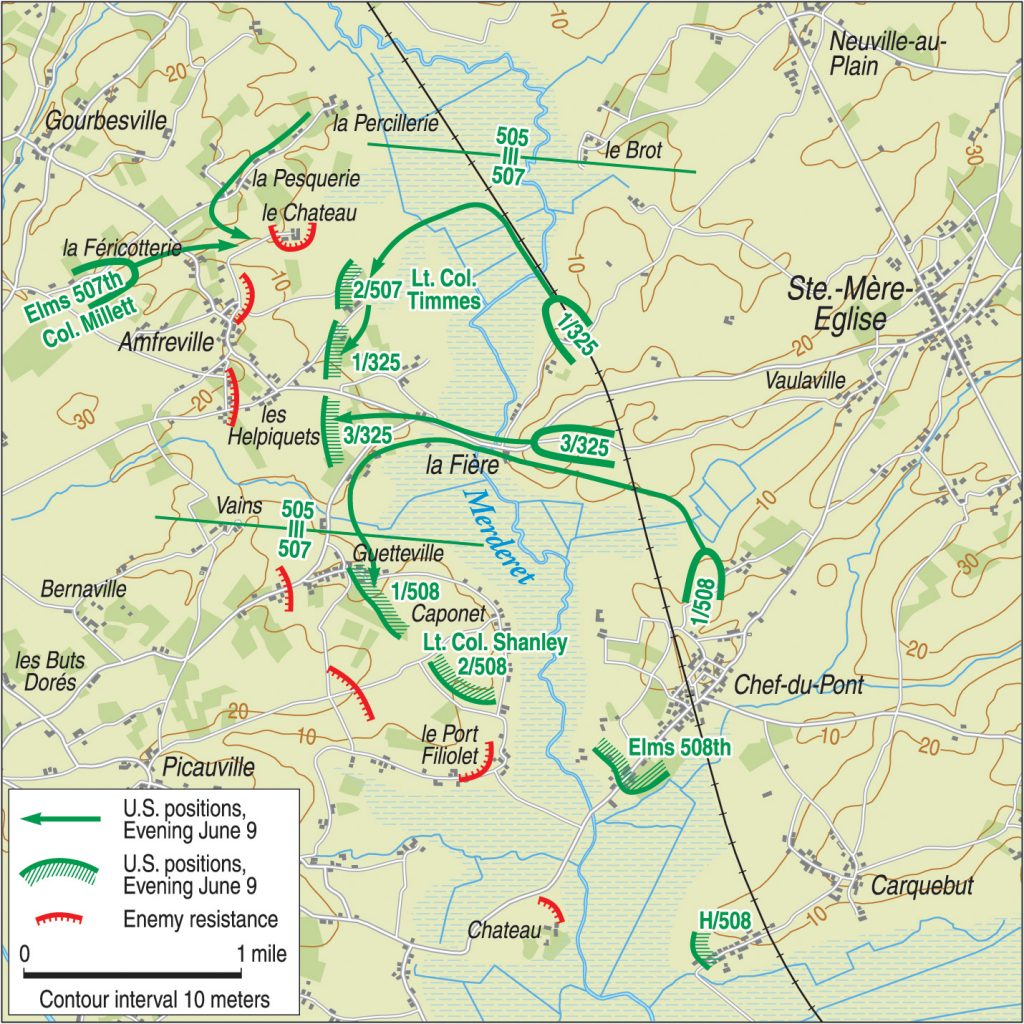
It took time for the 91st Division to get moving, due both to the confusion and their lack of transport. The division commander, Generalleutnant Wilhelm Falley, had to return to his unit in the darkness on June 6, having been away for a map exercise in Rennes. As he and his aide drove quickly down the dark French roads, the fortunes of war turned against them. American Lieutenant Malcolm Brannen, commander of the 508th PIR’s headquarters company, stood alongside the road questioning a French civilian when Falley’s car appeared. Brannen and the few paratroopers with him immediately started shooting, raking the car with gunfire. Both German officers died in the ambush.
Brannen later found the 82nd Airborne Division HQ and, laughing, told General Matthew Ridgeway how he had killed a division commander. Ridgeway replied, “Well, in our present situation killing division commanders does not strike me as being particularly hilarious. But I congratulate you. I’m glad it was a German division commander you got.”
This event caused further confusion for the German division, now lacking its commander. Leadership fell to Oberst (Colonel) Klaus Klosterkemper. Small groups of American paratroopers conducted raids on the 91st’s headquarters; in the confusion and darkness the Germans took these to be much larger forces. By 3:30 am the division lost communication with the troops defending the La Fière bridge.
A few miles east, Lieutenant John Dolan and A Company moved toward their objective. As the morning sun dawned slowly to their left, the Americans marched south, following the narrow dirt road their leader had spotted soon after landing. The hours spent studying maps and terrain models paid off. Soon they arrived at another T intersection; a turn to their left led toward Ste.-Mère-Église. Dolan knew to turn right toward the bridge. He also ran into his battalion executive officer, Major James McGinity, who chose to accompany Dolan and his men. As they prepared to move out, a German motorcycle suddenly appeared, racing east toward Ste.-Mère-Église. The rider passed without spotting the Americans, who let him go.
The company crossed to the south side of the road before continuing west. First Platoon led the way, followed by the company headquarters, then Third and Second Platoons in that order. A hedgerow separated the soldiers from the road, providing some concealment. Almost immediately, Dolan lost contact with First Platoon, so the Third took the lead. When they were about 700-800 yards from the bridge, the lane split, one fork leading southeast toward the bridge. This dirt road had hedgerows to either side. Heading toward the bridge, they found an open field about 100 yards deep and 75 yards wide. Dolan thought it was a good place for the Germans to set up defenses.
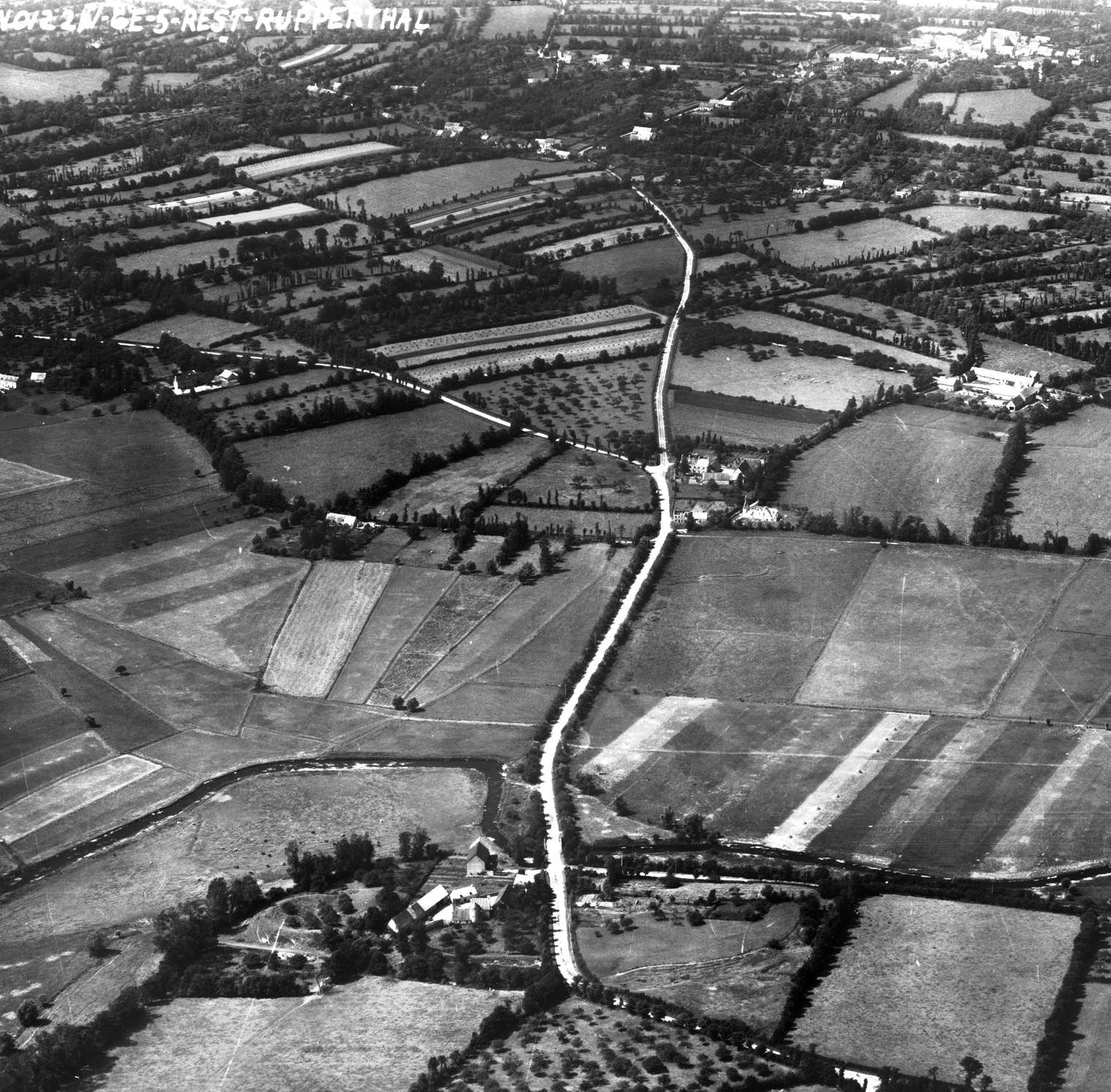
Since Third Platoon was up front, Dolan ordered its platoon leader, Lieutenant Donald Coxon, to send his scouts forward to reconnoiter. Coxon gathered a few men and decided to go with them. Dolan later wrote, “He had plenty of personal courage but he didn’t have the heart to order them out without going with them.” Moments after the scouting party moved out, a German machine gun opened fire from across the field. Coxon and a scout named Fergueson were killed immediately. The Americans returned fire, and bullets snapped across the field between the two sides.
Dolan knew he had to move quickly; he told his Second Platoon leader, Lieutenant Presnell, to lead his platoon around to the right, flank the German position, and advance all the way to the bridge if possible. Meanwhile, McGinity and Dolan took Third Platoon around the left, going after the machine gun. Presnell moved out and soon got to the bridge without taking any more fire. Third Platoon advanced until they thought they were even with the machine gun’s estimated position and then moved in for the kill.
McGinity took the lead, with Dolan a few steps behind. A high, thick hedgerow sat on their left, and Dolan thought the machine gun was on the other side of it. As they crept forward, rifle and submachine-gun fire tore through the hedgerow, killing Major McGinity. Dolan watched the leaves on the hedge shaking as bullets tore through it and used those spots as a reference to return fire with his Thompson submachine gun. The fire continued, snapping all around him, but Dolan spotted an empty German foxhole and dove into it. After taking cover he kept up the fire with his Thompson. Third Platoon’s assistant platoon leader, Lieutenant McLaughlin, and his radio operator were both hit; the lieutenant died later that day.
More fire came from the direction of the bridge, pinning down the Americans for at least an hour. Each time Dolan tried to move, German fire drove him back to cover. He could hear more firing down near the bridge. Finally, he tried moving again and received no fire. Dolan soon realized the Germans had pulled back. He went back to the platoon and told the sergeants and corporals to reorganize their men and stay where they were. Dashing across the road, Dolan found his First Platoon advancing toward the bridge and told its leader, Lieutenant Oakley, to keep going to the bridge and dig in on the north side of the road.
Dolan kept going and ran into his regimental commander, Lt. Col. Eckman, along with a group of paratroopers from the 508th PIR, whose assigned area lay a few miles west. Realizing the Germans had retreated and the bridge was in American hands, Dolan sent for Third Platoon to move up to the bridge and dig in on the south side of the road. While organizing his defense, he realized not all the Germans were gone. About 10-12 were hiding on the second floor of a stucco farmhouse south of the bridge, known as the Manoir. The Germans opened fire as Eckman and Dolan surveyed the bridge. They kept up their fire for about 20 minutes before surrendering. A squad of paratroopers from the 508th took the enemy troops prisoner. Dolan finished his preparations by placing his Second Platoon about 400 yards east of the bridge to protect the company’s rear.
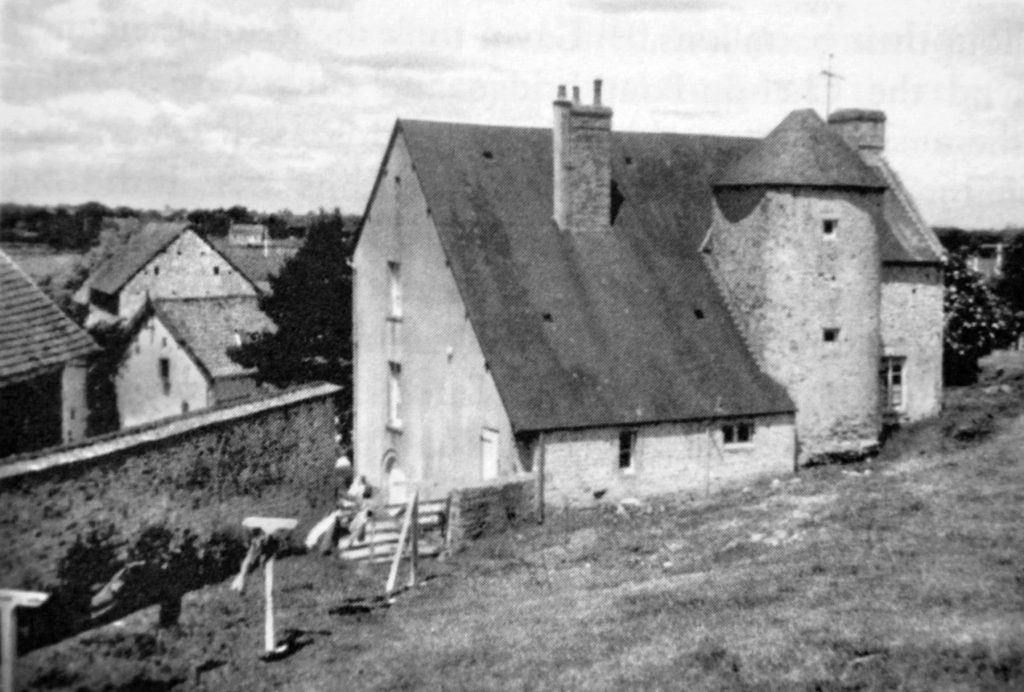
By 2:30 pm the paratroopers were ready to defend La Fière Bridge. The eastern side of the bridge and the manor house were in their possession. As the day progressed more American troops arrived. Major Kellam, the battalion commander, appeared with his operations officer (S-3), Captain Dale Roysden. They brought their command-post personnel and several machine-gun and mortar teams, adding welcome firepower. One platoon of B Company was put in the line along with some stray paratroopers separated from their units. A platoon of engineers showed up as well, assigned to destroy the bridge if necessary.
With all these soldiers in place, Dolan began inspecting his forward positions, noting the road leading west from the bridge was essentially a raised causeway with marshy ground on either side for about 1,000 yards. This would make attacks on the American line more difficult. Some paratroopers dashed across the bridge and laid mines across the road, while others pushed a broken-down German truck from the manor onto the road to block it on the east end.
A company of the 508th appeared from the east. They joined with the squad already there, and the whole group crossed the bridge and headed west toward their assigned objective. About an hour later, a few of them reappeared, retreating through the marshland. These survivors crossed the Merderet, which was shallow despite the flooded marshland. Dolan’s men helped them out of the water. German machine-gun fire started falling on the Americans. Dolan was sure an attack was coming. Luckily, A Company also got an additional reinforcement just before that attack began. Dolan got a single 57mm antitank gun assigned to protect the bridge. He placed it near his command post, about 150 yards from the bridge, where the road curved away to the right. This gave the gun crew a good field of fire covering the bridge and road and providing some cover from enemy fire.
Dolan also had three bazooka teams, two from his own company and one from another. The A Company teams dug in on each side of the American end of the bridge, one left and one right. Since the road was basically a raised causeway, the teams had to dig their foxholes below the level of the road for cover, and this required them to get out of their holes to shoot at anything on the roadway. The other bazooka team dug in farther south of the bridge, where there was better cover. A few mortar teams rounded out the American’s heavy weapons, but they were so low on ammunition they could only be used in emergencies.
With the defenses laid in, Dolan inspected them, joined by Major Kellam and Captain Roysden. The German machine-gun fire grew heavier. A trio of tanks appeared on the road; Dolan could not tell what kind but thought they were similar to a Panzer IV. In fact, they were two captured French Renault R35s and one Hotchkiss H39 supported by infantry from Grenadier Regiment 1057.
Marcus Heim and Lenold Peterson were the American bazooka team on the south side of the bridge. Heim recalled watching the tanks approach around a curve in the road across the bridge. He saw the commander of the lead tank rise from his hatch and look around. An American machine-gun team on Heim’s left fired, killing the tank commander. Within seconds the Germans opened fire, both tanks and infantry. The Americans shot back, and a general firefight broke out. The lead German tanks advanced toward the bridge, staying 15-20 yards apart, while the third tank kept 50 yards behind them. Each of them poured cannon and machine-gun fire at the GIs on the other side of the bridge.
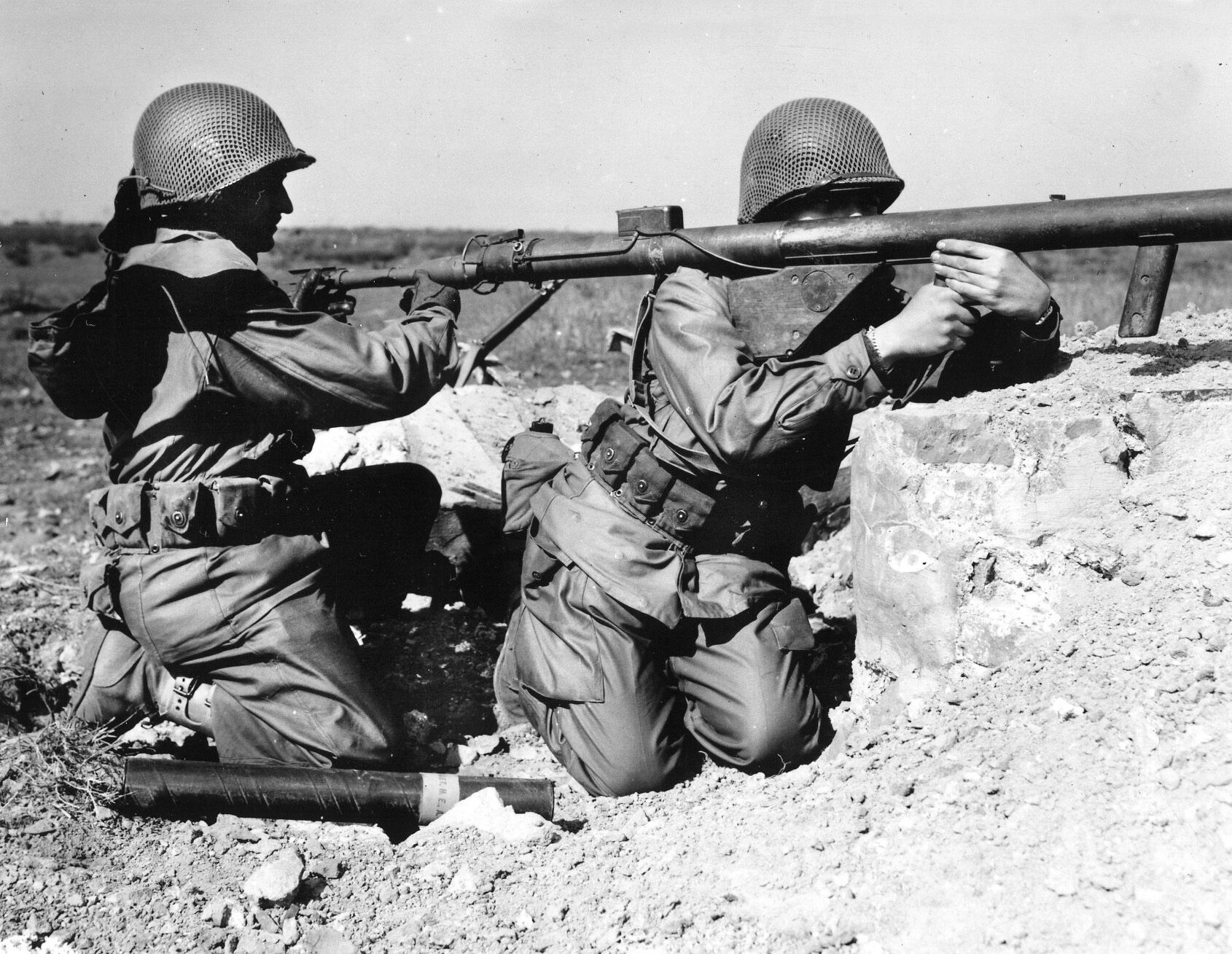
When the lead tank came within 40-50 yards of the bridge, both bazooka teams rose from their foxholes. Despite all the tank and small-arms fire coming at them, Dolan saw both teams calmly load and fire their bazookas, sending a hail of rockets at the closest tank. Heim and Peterson used a concrete telephone pole as cover while they fired. The rockets from both teams hit the first tank, breaking a track and causing it to slew sideways. Despite the hit, the tank’s turret turned to keep firing at the Americans. Heim loaded and Peterson fired again and again until the old tank burst into flames. The other team, John Bolderson and Gordon Pryne, achieved several hits as well, making it a shared kill.
A German shell hit the concrete pole; Heim and Peterson jumped out of the way as it fell. The second tank moved up, pushed the burning wreck aside, and advanced, firing as it came. Lacking the cover of the pole, Heim and Peterson moved forward to get a better shot at the tank. Heim recalled, “We kept firing at the second tank and we hit it in the turret where it is connected to the body, also in the track and with another hit it also went up in flames.”
Dolan thought only 30 seconds elapsed between the destruction of the two tanks. There was still the third tank to deal with, but his teams were low on rockets. Heim dashed across the road through the heavy fire to see if the other team had any to spare. “I still find it hard to believe I made it to the other side in one piece,” he later wrote.
On the other side, a dead paratrooper lay nearby, but Bolderson and Pryne were gone. German fire had hit their bazooka and rendered it inoperable, forcing them to fall back to cover. Heim saw the bazooka with holes in it and, luckily, several rockets. Grabbing them, Heim dashed back across the road to Peterson, again without being hit. Heim loaded and Peterson fired at the last tank, hitting it. Soon that tank was out of action as well. Though Heim could not know it in the heat of battle, the 57mm antitank gun had also struck the three enemy tanks with numerous rounds.
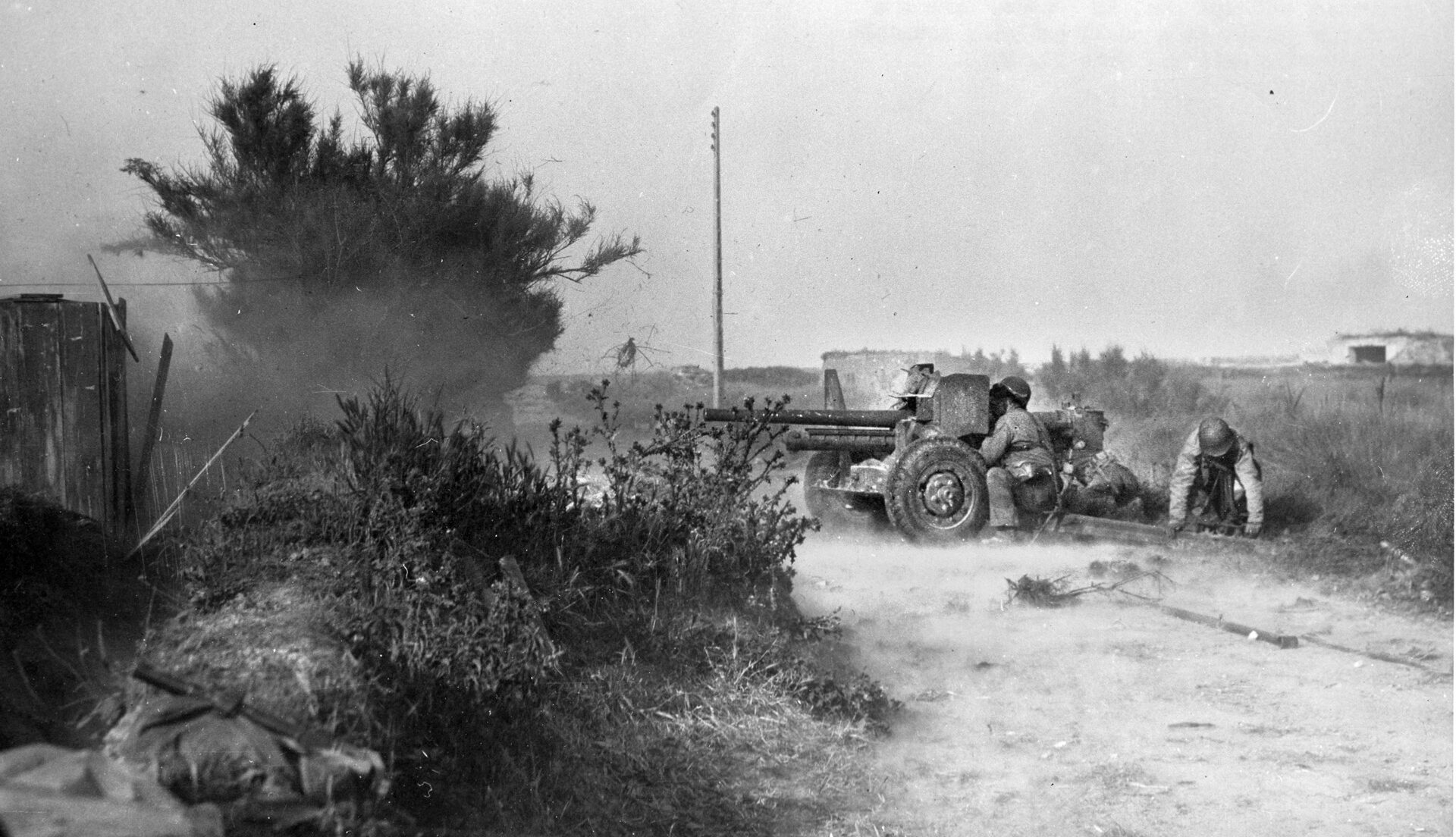
Despite its being farther back from the action, the Germans spotted the antitank gun and fired at it. During the battle, the gun was hit several times; German cannon rounds punched several holes through the gun’s shield. Sergeant Elmo Bell of C Company was present at the gun position. He noted that each time a crew member was hit another paratrooper rushed in to keep the vital gun in action. This was possible because the airborne units trained their men on all the weapons they might have to use in combat, including the 57mm antitank gun. In all, seven Americans died keeping the antitank gun operating during the battle. It paid off with three German tanks knocked out and the La Fière Bridge staying in American hands.
With the remaining bazooka crews low on ammunition, Major Kellam and Captain Roysden went forward with a resupply. When they were only 15-20 yards from the bridge, German mortar fire began crashing down around them, perhaps a belated effort to silence the American bazookas. Kellam died, and Roysden was mortally wounded; he died later in the day. This left Lieutenant Dolan as the ranking officer at the bridge, making him the battalion commander.
Dolan then received a temporary reprieve. With their tanks gone, the German grenadiers broke off their attack and fell back toward Cauquigny. Soon the rest of B Company became available, and Dolan put them behind A Company to form a 360-degree perimeter.
While the Germans reorganized for their next attack, they kept the Americans under a combination of artillery, mortar and machine-gun fire lasting until nightfall. Dolan remembered the enemy mortars in particular: “The mortar fire was very effective against the two forward platoons because of tree bursts. It took very little imagination on the part of the Krauts to figure out just where we would be dug in. As I recall, there was less than a 75-yard frontage on either side of the bridge from where we could effectively defend, so they could throw their mortar fire in our general direction with good results … My Third Platoon took the worst beating, as they were in a heavier wooded area (tree bursts).”
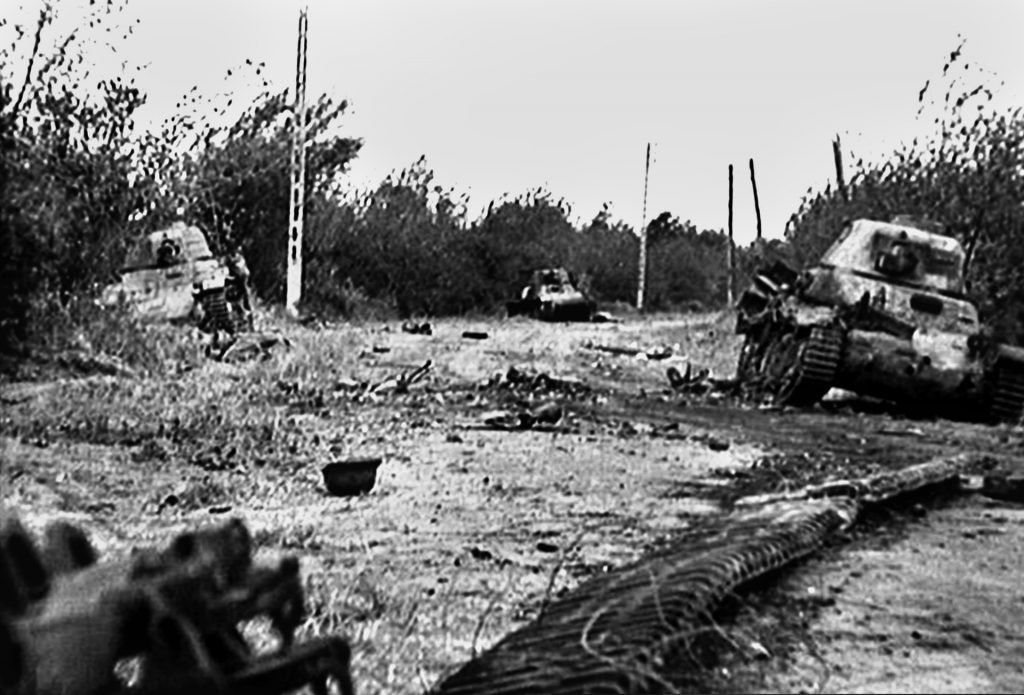
The incoming fire picked up the next morning and became heavier in the afternoon, heralding another attack. Dolan was with his First Platoon on the north side of the bridge when the mortar fire became even more intense and kept up for an hour. Third Platoon on the other side of the bridge was almost wiped out, losing their platoon sergeant, Sergeant Monaghan. Pinned down on the opposite side of the road, Dolan did not know how bad things were for them. A short time later, he heard some troops had retreated through Third Platoon’s position and then through the command post. A rumor spread the Americans were retreating from the bridge, which caused the gun crew of the 57mm to abandon it.
With their main antitank weapon unmanned at a critical moment, the second German attack started. Four more ex-French tanks with infantry came down the road. Two tanks led the way with infantry following; the second pair of tanks brought up the rear. The platoons at the bridge opened fire on the Germans but also took heavy fire themselves, suffering casualties that threatened the American hold on the bridge. The radios also failed, forcing the units to use runners to maintain communication. First Platoon’s leader, Lieutenant William Oakley, was gravely wounded and died a short time later. Private Ross, carrying the platoon’s walkie-talkie, was killed. This was a larger radio carried on the soldier’s back; World War II-era soldiers referred to the smaller, hand-held radio as a “handie-talkie.” This left the platoon isolated, and a squad leader named William Owens took command.
As the German tanks rumbled toward the bridge, Dolan noted he did not hear the 57mm gun firing; he was unaware the crew had left it. Dolan rushed back to the gun and found it unattended. He tried to fire it, but the crew had taken the firing mechanism when they left. In desperation, Dolan assembled a small group of five or six paratroopers and armed them with Gammon grenades. These handheld explosive charges required the user to get close enough to throw them on an enemy armored vehicle. This meant allowing the enemy tanks to cross the bridge so the paratroopers could run up to them, but there seemed no other choice.
Then, on their own initiative, two of the gun crew returned, carrying the firing mechanism. Dolan remembered them as two privates, perhaps 18 years old. The pair quickly got the cannon back into action and were soon firing 57mm antitank rounds at the lead German tanks. Within a few minutes both tanks were knocked out, blocking the causeway alongside the other tanks put out of action earlier. Dolan put both privates in for the Silver Star.
With both lead tanks destroyed, the tanks in the rear of the German formation could not get through to cross the bridge. Instead, their crews pulled back, likely to stay out of range of the remarkably effective antitank fire they had seen so far. The German infantry nevertheless pressed forward, using the destroyed tanks as cover. The waterlogged ground to each side of the causeway limited their ability to spread out, making it easier for the American troops to concentrate fire at them, just as it had allowed the German indirect fire to savage the paratroopers earlier. Soon the German infantry fell back, unable to overcome the wall of lead the GIs threw at them.
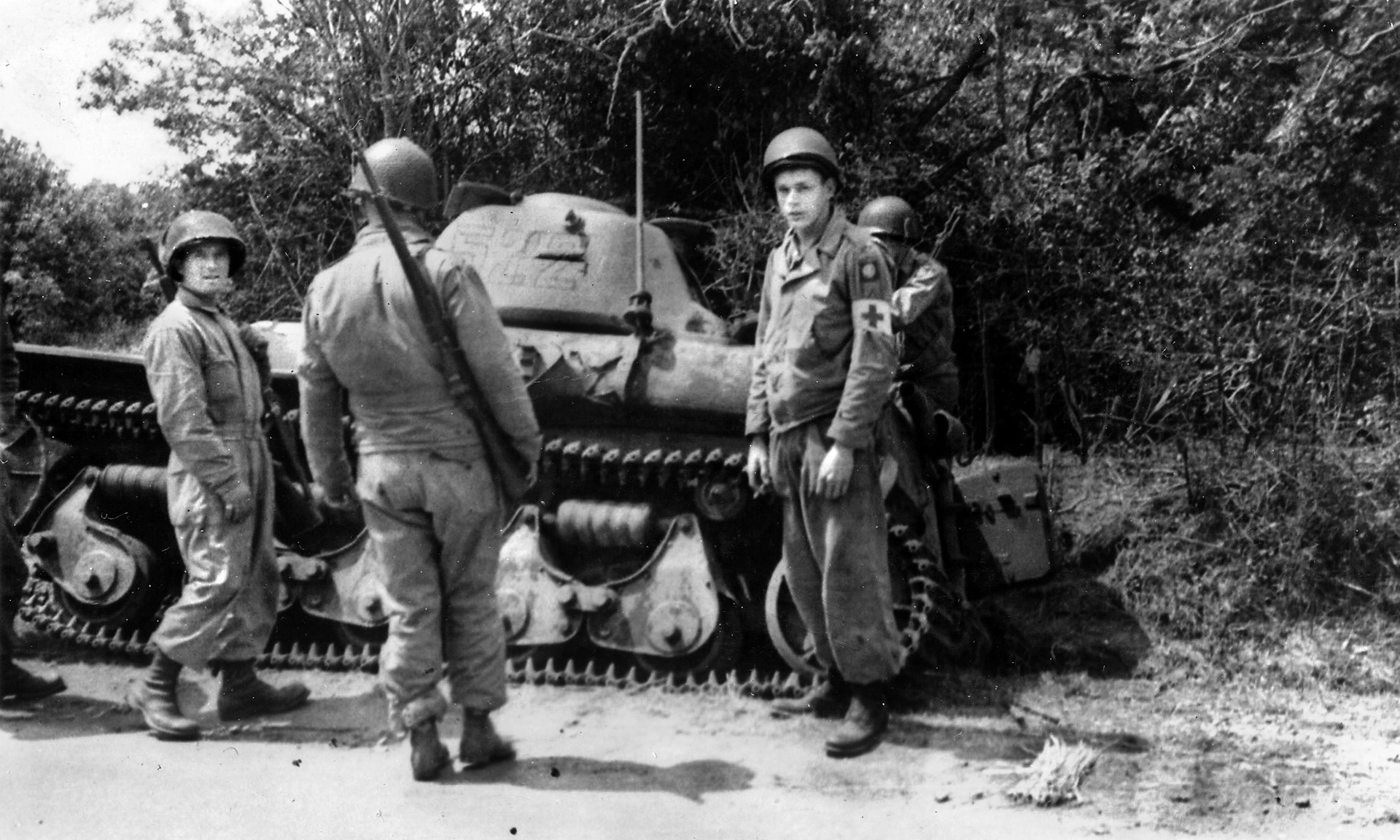
Instead, German artillery and heavy mortar fire came down again. Explosions dotted the east end of the bridge as shrapnel flew over the American foxholes. After First Platoon’s Lieutenant Oakley fell, Sergeant William Owens began crawling around the platoon’s position, checking each wounded or dead man for ammunition and grenades. He distributed what he gathered to his surviving men and got ready for the next attack, all while under the artillery and mortar fire. “I don’t know how it was possible to live through it,” Owens later wrote. His platoon had only 15 men left.
Another German attack came, this time only infantry; the tanks were blocked by the knocked-out hulks of their predecessors. Sergeant Owens fired at them with a .30-caliber machine gun, but soon it overheated. Crawling over to a wounded private named McClatchy, Owens took the soldier’s Browning Automatic Rifle (BAR) and used it, sending burst after burst at the Germans until he ran out of magazines for the weapon. After Owens ran out of ammunition for the BAR, he moved to another .30-caliber machine gun whose crew lay dead from a close artillery or mortar round. The tripod was unusable, so he rested the weapon on a pile of dirt. Another soldier took up a different machine gun, and behind them a 60mm mortar crew starting lobbing bombs at the advancing Germans, whom Owens stated were now within 25 yards of First Platoon’s position.
A runner appeared, one of the 505th’s Pathfinders—men who’d dropped before the main force and prepared the landing fields for their arrival. His name was Bob Murphy; he joined the Army in 1942 at 17 years old after forging a birth certificate with his own father’s help. Now employed as a runner, he was tasked to check A Company’s status. Learning the platoon was running out of both ammunition and men, Murphy ran back to Dolan’s command post and reported what he knew. Dolan wrote a quick note on a scrap of paper and told him to take it back to Owens. The note said. “I know of no better spot to die. We stay.”
Owens resolved to stay at his post with his remaining men, but what seemed like the moment of their last stand suddenly took a turn for the better. The firing died away, and a flag with a Red Cross symbol appeared waving over the heads of the Germans on the causeway. They requested a half hour to remove their wounded, and the Americans, themselves battered almost to the limit, quickly agreed. Owens moved even farther forward to get a better view and thought he saw about 200 German dead and wounded scattered around the causeway, with more in the Merderet. He also noted it took the enemy about two hours to evacuate their wounded. Afterward, the artillery and mortars started again, though a bit lighter than before. No more German infantry or armor appeared the rest of the day.
After dark, the paratroopers kept watch for another German attack. At about two in the morning, Owens heard engine noises from across the causeway. Fearing an impending night assault, he listened intently and soon discerned the sound of the Germans trying to use an armored vehicle to push one of the disabled tanks out of the way. Owens knew if the enemy got tanks over the bridge the Americans had little to stop them. He grabbed a few Gammon grenades and crawled onto the bridge, invisible to the enemy in the darkness. Debris and bodies littered the span as he slowly made his way across, guided by the sounds of the enemy troops trying to open a path. Owens figured he got about 30 or 40 yards from them before he decided to throw his first grenade. The Gammon worked differently from a normal hand grenade. The user unscrewed a cap on top of the weapon, exposing a small ribbon with a weighted end. Once thrown, the ribbon uncoiled, and the air resistance caused it to pull a small pin from the fuse. This armed the Gammon so it would explode as soon as it hit anything.
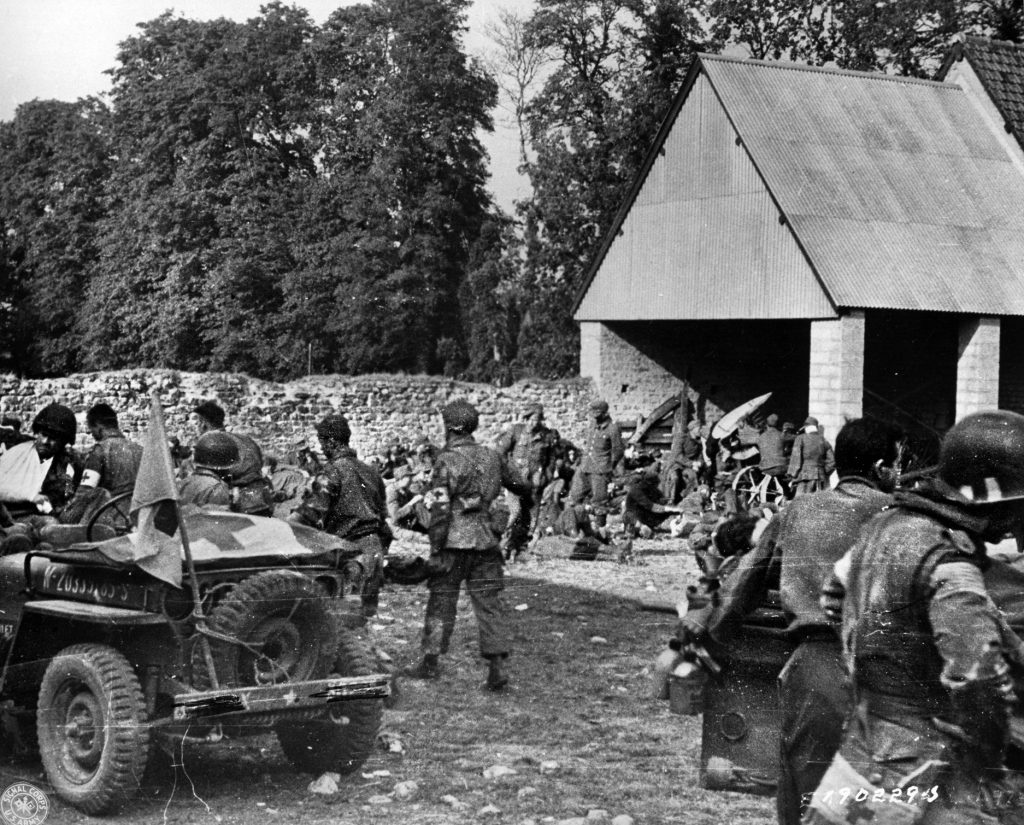
Owens unscrewed the cap on his Gammon and hurled it toward the sound of the tank engine, but in the darkness his aim erred a little and the grenade hit the disabled tank instead. The explosion sent a blast wave and debris flying through the night air. While it did not knock out the active tank, it awoke the vehicle’s crew to the threat in the darkness. The driver threw the tank into reverse and backed it out of range. The shelling resumed after that, but it was the last German attempt to retake the bridge.
Later that day, Lt. Col. Mark Alexander took command of the battalion, relieving Lieutenant Dolan. That night A Company was relieved of its duty to hold La Fière bridge by the 508th PIR. During the fight to hold it, A company lost 17 dead and about 51 wounded, according to Dolan. The men in the bazooka teams, Marcus Heim, Lenold Peterson, John Bolderson, and Gordon Pryne all received the Distinguished Service Cross for their bravery against the German tanks.
Dolan recommended Sergeant William Owens for the same award, but it was not given. “This is a story in itself,” Dolan later wrote without further explanation. Later promoted to staff sergeant and leading a platoon, Owens was awarded a Silver Star during Operation Market Garden in Holland in September 1944, for actions much like those he undertook at La Fière.
German casualties at the bridge are not exact, but the 91st Luftlande Division lost 2,212 men in the first six days of the Normandy fighting. It was further mauled during subsequent fighting and ceased to exist on August 10, 1944. The 82nd Airborne’s actions in the first few days of Operation Overlord enabled thousands of troops to come ashore and take the fight to the Germans, eventually leading to a breakout and advance all the way to the German border by mid-September.
The All-Americans made another airborne assault in Holland before fighting in the Battle of the Bulge. From there, they fought into Germany itself to help end the war.
Author Christopher Miskimon is a regular contributor to WWII History. He writes the regular books column and is an officer in the Colorado National Guard’s 157th Regiment.
